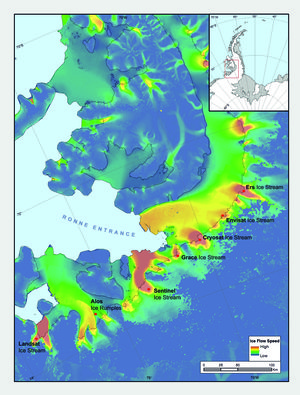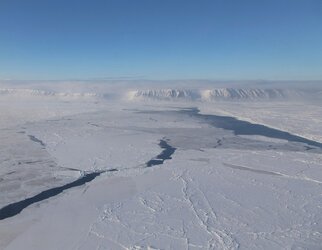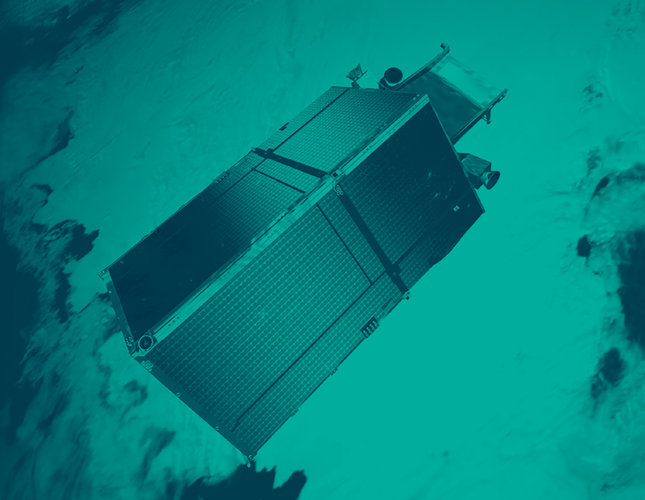Places in Antarctica named in honour of ice scientists
Celebrating 200 years since the discovery of the Antarctic continent, the UK Committee for Antarctic Place-Names has named 28 mountains, glaciers and bays after modern-day scientists who have advanced our understanding of this remote continent. Four of the names on the list have strong links to ESA, having either worked on the development of polar-orbiting altimetry missions such as ERS-1, ERS-2, Envisat and CryoSat, or subsequently by using their data together with other satellite missions for key polar research projects.
Named in honour of Seymour Laxon, Laxon Bay lies in the northwest of the Antarctic Peninsula. Prof. Laxon was the Director at the Centre for Polar Observation and Modelling at University College London. His research pioneered the use of satellite altimetry to measure the gravity field, sea-ice thickness and surface circulation in the polar oceans. His work provided evidence that enabled the development of the CryoSat mission.

Named after Katharine Giles, Giles Bay also lies in the northwest of the Antarctic Peninsula. Dr Gilles’ research focussed on sea ice, ocean circulation and wind patterns, and the use of satellite altimetry to measure the thickness of Arctic and Antarctic sea ice.
Both Prof. Laxon and Dr Gilles were instrumental in a number of ESA’s polar field experiments to support the CryoSat mission.
Sadly, they died within months of each other in 2013 as a result of two separate tragic accidents in the UK.
Jonathan Bamber is currently Professor of Physical Geography at the University of Bristol and now has Bamber Glacier on Adelaide Island named in his honour. Prof. Bamber is a specialist in using satellite altimetry to study the morphology and dynamics of the Antarctic and Greenland ice sheets and ice shelves, and the contribution of land ice to sea-level change.

ESA’s Mark Drinkwater said, “The scientific advances made by the UK scientists Seymour Laxon, Catherine Giles and Jonathan Bamber using satellite altimetry data have been ground breaking and pivotal for ESA. Each added successive layers to our understanding of how polar ice and the polar oceans respond to climate change. Their respective contributions are unique, and have led to the success of ESA’s dedicated polar-orbiting ice mission CryoSat.”
CryoSat has now been in orbit for well over 10 years measuring variations in the height of Earth’s ice to reveal how climate change is affecting the polar regions. It has contributed to the recent worrying findings that Greenland and Antarctica are now losing ice six times faster than in the 1990s, which has clear implications for future sea-level rise. Information such as this is vital for international policy making in responding to climate change.
Fricker Ice Piedmont, on the eastern side of Adelaide Island, honours Helen Fricker. Prof. Fricker is the founder and co-lead of Polar Center at Scripps Institution of Oceanography, UC San Diego, California. She too has played an important scientific role in ESA’s ERS, Envisat and CryoSat missions. As glaciologist and current science team member on NASA’s ICESat and ICESat-2 missions she has worked on Antarctic ice shelf evolution and change detection, and Antarctic subglacial hydrology. More recently, she also worked on the project that involved synchronising CryoSat’s orbit with that of ICESat-2 so that scientists can benefit from simultaneous measurements and from the synergy between these different space sensors.
ESA’s CryoSat mission manager, Tommaso Parrinello, said, “It’s wonderful to see that these scientists, who have contributed so much to CryoSat, now have their names forever in Antarctica.

“The development of CryoSat started many years ago when Seymour Laxon was instrumental in its conception. The mission continues to amaze us by returning fantastic science. We are just now looking into the findings of having CryoSat and ICESat-2 aligned in orbit, and here we also have Helen Fricker to thank for the part she has played in this important change.”
The new names will feature on all British maps, charts and publications and are being put to the Scientific Committee on Antarctic Research for inclusion in its international directory, which should lead to all other nations using the names, too.















 Germany
Germany
 Austria
Austria
 Belgium
Belgium
 Denmark
Denmark
 Spain
Spain
 Estonia
Estonia
 Finland
Finland
 France
France
 Greece
Greece
 Hungary
Hungary
 Ireland
Ireland
 Italy
Italy
 Luxembourg
Luxembourg
 Norway
Norway
 The Netherlands
The Netherlands
 Poland
Poland
 Portugal
Portugal
 Czechia
Czechia
 Romania
Romania
 United Kingdom
United Kingdom
 Slovenia
Slovenia
 Sweden
Sweden
 Switzerland
Switzerland

































